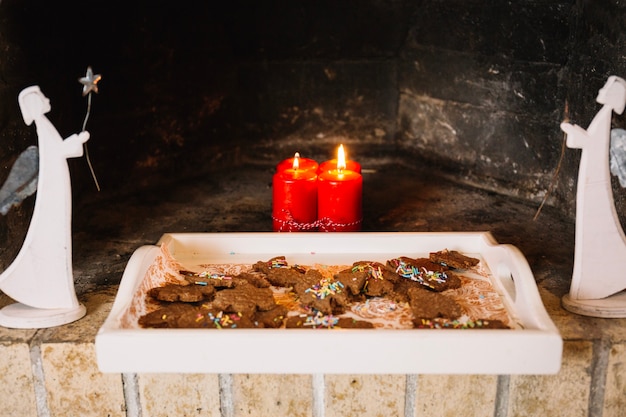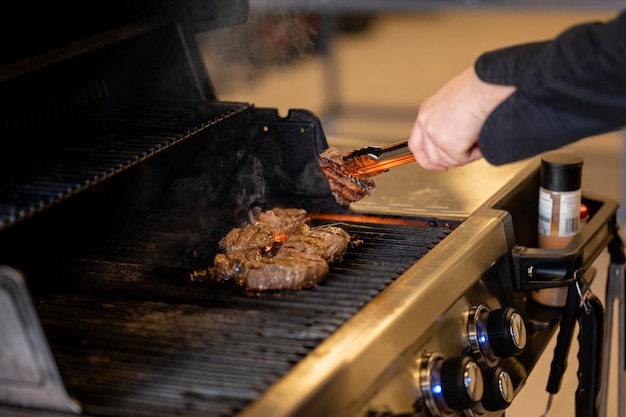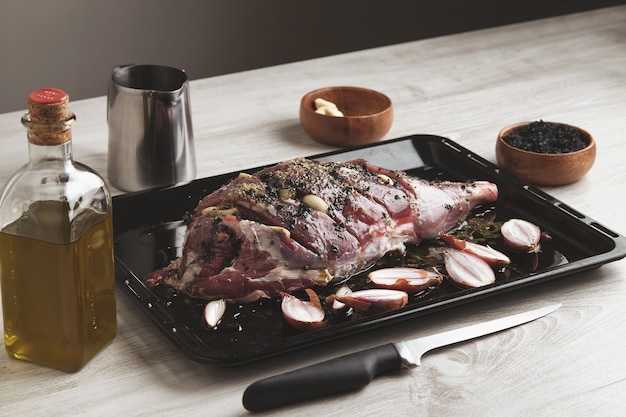Let's talk ribeye. You know, that gloriously marbled, juicy cut of beef that makes your mouth water just thinking about it? I'm a bit of a steak enthusiast myself, and I've spent years perfecting my oven-roasted ribeye technique. Trust me, there's nothing quite like a perfectly cooked, melt-in-your-mouth ribeye. It's a culinary experience that deserves to be savored.
This guide is all about sharing my passion for this beautiful cut of meat and taking you through the entire process, from selecting the perfect ribeye to achieving that coveted sear and ensuring the perfect level of doneness. It's a journey, but I promise, it's worth every step.
(Part 1) Choosing Your Ribeye: The Foundation of a Great Steak

The Cut: Prime or Choice?
choosing the right ribeye is the first step in creating a truly spectacular steak. When it comes to grade, I'm a big fan of prime. It's a little more indulgent, but the extra marbling and flavor are worth it. If you're looking for something more budget-friendly, choice is still a fantastic option, especially if you're opting for a thicker cut.
The Thickness: It’s All About the Heat
The thickness of your ribeye is crucial because it dictates how it'll cook. A thicker cut requires a slower, more even heat to ensure the inside cooks through without overcooking the exterior. Thin ribeyes, on the other hand, cook much faster, demanding a higher heat and a shorter cooking time. Think of it like a delicate dance between heat and time.
Marbling: A Sign of Flavor
Let's talk about marbling. Those beautiful streaks of fat running through the muscle aren't just about aesthetics; they add incredible flavor and tenderness. You want a ribeye with a good amount of marbling, as it'll make for a richer, more flavorful steak. Imagine those fat streaks melting into the meat, creating an explosion of flavor in every bite.
(Part 2) Prepping Your Ribeye: Getting Ready for the Oven

Pat It Dry: A Crucial Step
First things first: pat your ribeye dry with paper towels. This might seem like a tiny detail, but it's essential for achieving that glorious sear. A dry surface allows the steak to brown properly, creating that crisp, caramelized crust we all love. A wet surface, however, will steam, resulting in a less-than-ideal crust.
Seasoning: The Art of Enhancing Flavor
Now for the fun part: seasoning. My go-to seasoning is simple, yet effective: salt and pepper. I prefer coarse salt, as it dissolves slowly and adds a beautiful crust. Don't be afraid to be generous with the salt. Salt brings out the natural flavors of the steak, creating a more complex and delicious experience.
Let it Rest: A Must for Even Cooking
Before tossing your ribeye into the oven, let it rest at room temperature for about 30 minutes. This allows the steak to come to a more even temperature, leading to a more even cooking process. Imagine a symphony of heat working its magic on the steak, cooking it from the inside out.
(Part 3) The Oven-Roasted Technique: Achieving the Perfect Doneness

Preheat the Oven: A Crucial Starting Point
A hot oven is your best friend when it comes to roasting ribeye. Preheat your oven to 450°F (232°C) for a truly sizzling sear. I always preheat for at least 30 minutes to ensure the oven reaches the desired temperature. Imagine that heat penetrating the steak, creating a perfect balance of crispness and tenderness.
Searing: The Key to a Crispy Crust
Searing your ribeye is a crucial step for achieving that iconic crust. Heat a large cast iron skillet or oven-safe pan over high heat. If you're using a cast iron skillet, preheat it on the stovetop before transferring it to the oven. Once the pan is piping hot, add a tablespoon or two of oil. Then, carefully place your ribeye in the hot pan. You'll hear that beautiful sizzle as the steak hits the pan, a sound that signals the beginning of a delicious transformation.
The Sear: A Dance of Heat and Time
Now, sear each side of the steak for about 3 minutes. You'll see the steak develop a beautiful golden-brown crust. That's exactly what you want, a crust that's both visually appealing and packed with flavor.
roasting time: The Final Stage
Once your ribeye is seared on both sides, it's time to transfer it to the oven. Place the pan with your ribeye in the preheated oven and roast for 10-15 minutes, depending on the thickness of the steak and the level of doneness you prefer.
(Part 4) How to Gauge Doneness: A Guide to Perfection
The Touch Test: A Hands-On Approach
There are several ways to check for doneness, but the touch test is my go-to. It's simple and effective. Just press on the centre of the steak. If it feels soft and squishy, it's rare. Firm but still springy? It's medium-rare. Firm but yielding? It's medium.
The Internal Thermometer: For Precision
If you prefer a more accurate approach, an instant-read thermometer is your best friend. For rare, aim for 125°F (52°C). For medium-rare, it's 130°F (54°C). For medium, it's 140°F (60°C).
(Part 5) Letting Your Steak Rest: A Crucial Step for Juiciness
The Rest: The Secret to Juiciness
Once your ribeye reaches your desired level of doneness, it's time for a crucial step: resting. Take the steak out of the oven and let it rest for 10-15 minutes before slicing and serving. This allows the juices to redistribute throughout the steak, resulting in a much juicier and more tender steak.
(Part 6) Serving Your Roasted Ribeye: A Feast for the Senses
Slicing: An Art Form
Once your steak has rested, you can start slicing. I like to slice against the grain, as it makes the steak even more tender. If you're serving a thick ribeye, you might want to slice it in half to ensure even cooking throughout.
The Sides: A Symphony of Flavors
A roasted ribeye is incredibly versatile and pairs perfectly with so many sides. I love serving mine with a simple side salad, roasted vegetables like asparagus or Brussels sprouts, or creamy mashed potatoes.
(Part 7) Going Beyond the Basics: Mastering the Art of Ribeye
Wine Pairing: Elevating the Experience
A glass of wine can elevate your ribeye experience to a whole new level. I find that a full-bodied red, like Cabernet Sauvignon or Merlot, complements the richness of the steak perfectly. The tannins in the wine cut through the fattiness of the steak, creating a harmonious dance of flavors.
Experiment with Herbs and Spices: Unleashing New Flavors
While salt and pepper are classic staples, don't be afraid to experiment with other herbs and spices. Rosemary, thyme, garlic, and even a touch of paprika can add wonderful depth of flavor to your ribeye. Imagine the aroma of rosemary wafting through the air as your steak cooks, creating a truly enticing experience.
Trying Different Techniques: Expanding Your Steak Repertoire
Once you've mastered the oven-roasted ribeye, you can explore other techniques like grilling or pan-searing. Every method brings a unique flavor and texture to the steak. Think of it as expanding your steak repertoire, adding new dimensions to your culinary adventures.
(Part 8) FAQs: Answering Your Ribeye Questions
1. Can I use a cheaper cut of beef for oven-roasting?
While a ribeye is the ultimate choice for oven-roasting, you can certainly use other cuts. For a more budget-friendly option, try a chuck roast or top sirloin. Just remember to adjust the cooking time based on the thickness and cut of the meat.
2. How do I know if my ribeye is fresh?
A fresh ribeye should have a bright red color and a firm texture. Avoid any steaks that have a grayish hue or a slimy feel, as this could indicate spoilage.
3. Can I marinate my ribeye before roasting?
Yes, marinating can add a wonderful burst of flavor to your ribeye. Just be sure to use a marinade that complements the steak's natural flavors. A simple marinade of soy sauce, olive oil, garlic, and herbs can work wonders.
4. What's the best way to store leftover ribeye?
Leftover ribeye can be stored in the refrigerator for up to 3-4 days. Wrap it tightly in plastic wrap or foil to prevent it from drying out. You can also freeze leftover steak for up to 3 months.
5. Can I cook a ribeye from frozen?
It's not recommended to cook a ribeye from frozen. It's best to thaw it in the refrigerator overnight before cooking. This will allow the steak to cook more evenly and prevent it from becoming tough or dry.
Conclusion: A Culinary Adventure with Every Bite
So there you have it, your ultimate guide to oven-roasting a juicy, flavorful ribeye. Remember, it's all about embracing the process, from choosing the perfect cut to resting the steak properly. With a little practice and the right technique, you can create a steak that's both delicious and impressive. And who knows, you might even discover a new passion for the art of cooking steak.
Now, go on and get those taste buds tingling. Happy cooking!
Everyone is watching

Perfect Rice Every Time: The Ultimate Guide to Cooking Rice
Cooking TipsAs a self-proclaimed foodie, I've always been a bit obsessed with rice. It's the foundation of countless cuisi...

Prime Rib Roast Cooking Time Chart: Per Pound Guide
Cooking TipsPrime rib roast. Just the name conjures images of lavish dinners, crackling fires, and hearty laughter. It’s ...

The Ultimate Guide to Cooking Asparagus: Tips, Techniques, and Recipes
Cooking TipsAsparagus. The mere mention of this spring delicacy conjures up images of vibrant green spears, crisp and burs...

Ultimate Guide to Cooking the Perfect Thanksgiving Turkey
Cooking TipsThanksgiving. Just the word conjures up images of overflowing tables laden with delicious food, the scent of r...

How Long to Bake Potatoes in the Oven (Perfect Every Time)
Cooking TipsBaked potatoes are a staple in my kitchen. They're incredibly versatile, delicious, and surprisingly easy to m...
